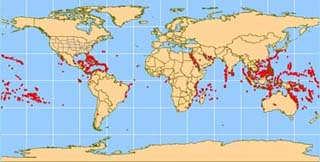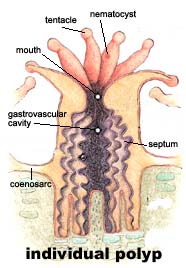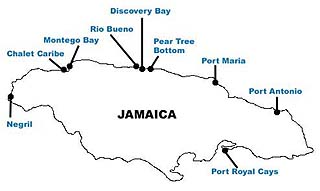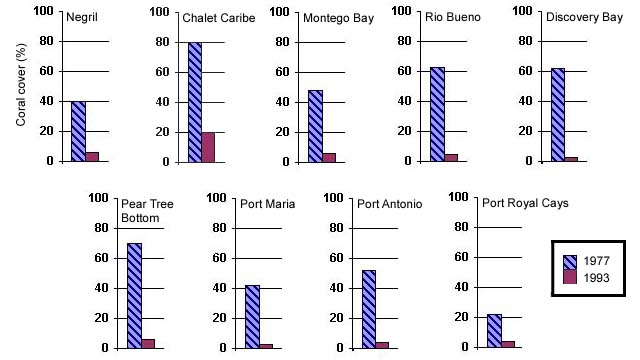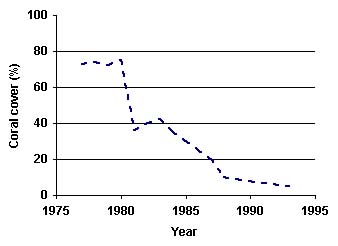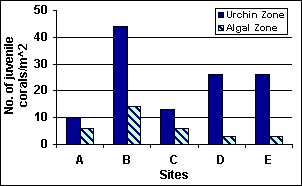Four to five percent of all described species on earth occur on tropical coral reefs. Coral reefs are considered oases within marine nutrient deserts because productivity associated with reefs may be many thousand times higher than in the open ocean surrounding coral reefs. They create a physical structure that provides food and protection for many tropical organisms, including humans.
Reef-building corals are responsible for the framework of coral reef systems – they are the primary structure of the entire reef. The corals create substrate that provide attachment sites for other corals, macroalgae, and countless taxa of invertebrates, not to mention hiding spots for the hundreds of fish and invertebrates species that reside throughout the reef.
Corals are invertebrates in the Phylum Cnidaria, which include sea jellies and anemones. There are many types of corals such as soft corals, hard corals, gorgonians, and hydrozoans. Corals responsible for building the impressive coral reef communities belong in the order Scleractinia.
These corals, also referred to as reef-building corals, have a symbiotic relationship with the brown dinoflagellate, zooxanthella. Most reef-building corals host around 0.5x10^6 to 5x10^6 zooxanthellae per cm^2 of living surface tissue.
Coral reefs dominate coastal tropical environments between latitudes 25 æS and 25 æN. Their distribution is highly dependent on abiotic factors such as light, water temperature, and salinity.
- LIGHT: Coral diversity is low near the surface, reaches a maximum between 15 and 30 m, and then drops again with increasing depth.
- TEMPERATURE: Corals require water temperature ranging between 18 æC and 30 æC.
- SALINITY: Corals are most successful in salinities that range from 32‰ to 40‰. They are found within the top 100 m of tropical oceans, and thrive in environments with a high degree of stability.
|
|
Reef-building corals are colonial organisms composed of hundreds to hundreds of thousands of individual polyps. Similar to sea jellies and anemones, coral polyps use their tentacles to capture & ingest food, clear away debris from their mouth, and act as the animals' primary means of defense. Nematocysts, or stinging cells, are found throughout the tentacles and epidermis. The zooxanthellae reside in the cells of individual coral polyps. Corals enable zooxanthellae to survive by supplying them with crucial nutrients (ammonia and phosphate) from their waste metabolism ). Meanwhile, the zooxanthellae selectively leak amino acids, sugars, and complex carbohydrates to their host. Up to 90% of the nitrogen utilized for protein synthesis in zooxanthellae is recycled within the coral host. |
|
||||
| TO BUILD A REEF | A
coral polyp needs a hard, clear substrate, such as rocks or dead coral,
on which to settle. It then secretes a skeleton of calcium carbonate.
This is the protective cup in which the polyp sits. The polyp can
completely contract into the cup when physically stressed. Occassionally,
the polyp lifts itself off the base and secretes a new floor to its
cup above the old one. This creates a minute chamber in the skeleton.
The polyps are connected to each other laterally via the coenosarc. All the thousands of polyps are performing this same secreting act to form the crucial massive reef structures. These structures provide substrate for other larvae to settle. The other larvae can include the same coral species, other coral species, and even macroalgae. photos courtesy of CorIS and John Reed |
||||
 |
|||||
 |
|
||||
Here is data from a study that compared the changes of reef-building corals in Jamaica over time. Figure 3 is a map showing the location of the nine coral reef sites around Jamaica. Figure 4 compares the percent of reef-building coral inhabiting and thus covering the sea floor of nine areas around Jamaica in 1977 and 1993.
There is a dramatic change in community structure all around the island. In less than 20 years, coral no longer dominated the ecosystems around the island.
- What could have caused such a dramatic change in the coral reefs present?
- How do you think this has impacted the ecosystem as a whole?
(Figures modified from data presented in Hughes, 1994)
|
|
|
Analyzing annual surveys of percent coral cover around Jamaica from 1977 to 1993 revealed sudden drops in 1981, 1984, and 1988. There were signs of recovery from the 1981 decline until 1983, then percent coral cover fell abruptly again by 1984. The survey data suggest that there have not been recovery of coral cover since 1983.
- What could have caused these abrupt drops in coral cover?
- What is keeping the reef-building corals from recovering?
- Compare these results with algal cover findings from the same study.
These results show that there are more juvenile corals in the urchin zones compared with algal zones.
- What could allow for the higher density of juvenile corals in the urchin zones compared with algal zones at these study sites?
- Compare this result with D. antillarum and macroalgae abundance in these areas during the same study.
- What do you think happens to corals when in contact with or proximity to macroalgae?
|
This web site was created by Lynn Tran at the North Carolina State University, Department of Mathematics, Science, and Technology Education on 7/12/03. Faculty advisor Dr. David Eggleston, NCSU, Department of Marine, Earth, & Atmospheric Sciences. Last updated December 29, 2003 .
